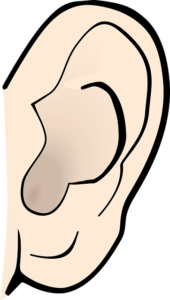Facts, Function, and Diseases of the Ear
The ear is much more than a hearing organ. It is a complicated set of elements that allows humans to hear and walk.
What is the size of a human ear?
Ears come in a range of shapes and sizes. The ears of men are larger than those of women.
According to the study, the average ear is 2.5 inches (6.3 cm) long, with an earlobe that is 0.74 inches (1.88 cm) long and 0.77 inches (1.96 cm) wide. They also noticed that as people become older, their ears become more prominent.
Women's ears grow less than men's ears, according to researchers in Germany who published their findings in Anthropologischer Anzeiger: Journal of Biological and Clinical Anthropology in 2007.
The longest ear length measured in the study was 2.4 inches (6.1 cm) for a 20-year-old woman, but it jumped to 2.8 inches (7.2 cm) for women over 70.
This length was 2.6 inches (6.5 cm) in men aged 20 and 3 inches (7.8 cm) in adults aged 70 and over.
A second study from Texas Tech University backed up the same finding. According to the study, ear diameter increases by 0.51 mm every year on average as people age, most likely due to collagen changes.
The mathematical link between age and ear diameter is as follows: ear circumference in mm = 88.1 + (0.51 x age of the person).
The circumference of the ear, on the other hand, can be used to calculate a person's age using the equation: age of the person = 1.96 x (ear circumference in mm – 88.1).
How do the ears work?
The outer ear, middle ear, and inner ear are the three ear regions. They all provide different but critical functions in terms of hearing and balance.
What is the mechanism of hearing?
The auricle, also known as the pinna, is a component of the ear that consists of a cartilage and skin loop on the exterior of the head. It functions similarly to a megaphone.
Sound waves are transported via the outer ear and into the external ear canal, according to Nebraska Medicine.
The ear canal is the visible part of the ear opening when looking at an ear up close.
When sound waves impact the thin layer of connective tissue, it vibrates in the same way that a drum is struck with a drumstick.
The vibrations enter the middle ear, also known as the tympanic cavity, after passing through the eardrum.
The tympanic cavity, according to the Encyclopedia Britannica, is lined with mucous membrane and filled with air. The ossicles are composed of three microscopic bones known as the malleus (hammer), incus (anvil), and stapes (stirrup).
According to the National Library of Medicine, bones vibrate when they move. When the blood arteries dilate, the stapes pushes an oval window structure in and out (NLM).
This action is transmitted to the inner ear and cochlea, which is a fluid-filled spiral structure that houses the spiral organ of Corti, the hearing receptor organ.
The microscopic hair cells in this organ convert vibrations into electrical impulses that are transmitted to the brain via sensory nerves.
How the ears help with balancing
The Eustachian tube, commonly known as the pharyngeal tube, balances middle ear air pressure with ambient pressure. This treatment aids people in maintaining their balance.
The vestibular complex in the inner ear is also important for balance because it contains receptors that regulate the experience of balance.
The vestibulocochlear nerve sends information about sound and balance from the inner ear to the brain.
Diseases and disorders of the ears
The ear is a delicate organ that can be harmed by injury, bacteria, or just environmental changes.
Ear infections are the most common condition among babies and young children, according to the NLM.
Common ear infection symptoms include drainage from the ear, hearing loss, ear discomfort, fever, headache, ear pain, and a sense of fullness in the ear.
Meniere's disease is an inner ear disorder caused by fluid accumulation in the ear.
Symptoms include hearing loss, pressure or pain, dizziness, and tinnitus. Tinnitus is characterised by ringing in the ears.
Loud sounds, narcotics, and a variety of other conditions can all play a role.
The National Library of Medicine defines barotrauma as ear injury induced by variations in air or water pressure. It typically occurs during airline journeys, high-altitude travel, or diving into deep seas.
Some of the symptoms include pain, blocked ears, hearing loss, and dizziness. Barotrauma is commonly relieved by “popping” the ears by yawning, chewing gum, or attempting to blow outside with the nose and mouth closed.
Earwax, also known as cerumen, is antibacterial and serves to lubricate and protect the ear.
According to the American Academy of Otolaryngology, normal amounts should not bother most people, although earwax can build up and should be removed on a regular basis. Ear congestion, coughing, odour, discharge, itching, and hearing loss are all signs of earwax.
Impairment of hearing
The elderly are not the only ones who suffer from hearing loss. Two to three out of every 1,000 babies in the United States have hearing loss in both ears.
Hearing loss affects 15% of persons in the United States aged 18 and over.
Nonetheless, the NIDCD reports that age is the most important predictor of hearing loss in persons aged 20 to 69. Hearing loss normally worsens with age, though ear damage can cause hearing loss at an early age.
For hours on end, we are usually glued to our phones and music players. The sensitive cells in the inner ear are injured when we expose our ears to dangerous sounds. Regrettably, the harm accumulates over time.
Improving Ear Health
Hearing that has been damaged cannot be healed naturally. The majority of people with hearing loss require surgery or hearing aids. “The good news is that it is entirely avoidable,” Cherukuri says. “When using earplugs or headphones, I advise my patients to adhere to the 60-60 rule: no more than 60% of full volume for more than 60 minutes at a time.”
People who engage in loud activities or hobbies, such as athletic events, music concerts, shooting sports, motorcycling, or lawn mowing, should safeguard their hearing by using earplugs or noise-cancelling headphones.
Brushing properly is another method for preventing hearing loss and damage. The American Academy of Otolaryngology recommends cleaning the outer ear using a towel.
Then, in the ear, put a few drops of mineral oil, baby oil, glycerin, or commercial drops to soften the wax and make it easier to drain.
A few drops of hydrogen peroxide or carbamide peroxide may also be beneficial in the healing process. You should never put anything in your ear.
Brought To You By – Ear Wax Removal Cambridge
The post Facts, Function, and Diseases of the Ear appeared first on https://gqcentral.co.uk






Comments are closed